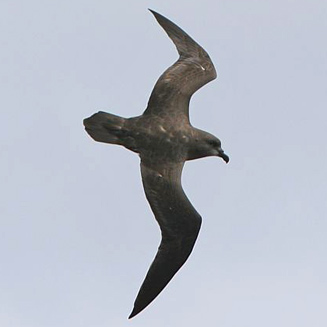|
Pterodroma macroptera
(Great-winged petrel)
Langvlerkstormvoël [Afrikaans]; Langvleugelstormvogel
[Dutch]; Pétrel noir [French]; Langflügel-sturmvogel [German];
Freira-d'asas-grandes [Portuguese]
Life
> Eukaryotes >
Opisthokonta
> Metazoa (animals) >
Bilateria >
Deuterostomia > Chordata >
Craniata > Vertebrata (vertebrates) > Gnathostomata (jawed
vertebrates) > Teleostomi (teleost fish) > Osteichthyes (bony fish) > Class:
Sarcopterygii (lobe-finned
fish) > Stegocephalia (terrestrial
vertebrates) > Tetrapoda
(four-legged vertebrates) > Reptiliomorpha > Amniota >
Reptilia (reptiles) >
Romeriida > Diapsida > Archosauromorpha > Archosauria >
Dinosauria
(dinosaurs) > Saurischia > Theropoda (bipedal predatory dinosaurs) >
Coelurosauria > Maniraptora > Aves
(birds) > Order: Ciconiiformes
> Family: Procellariidae
 |
|
|
Great-winged petrel, offshore from Cape Town, South Africa. [photo
Trevor Hardaker ©] |
|
Distribution and habitat
Breeds on sub-Antarctic islands and islands off New Zealand
and south-west Australia, after which it disperse across southern oceans from
20-48° South. It is common in across southern African waters, although more
scarce off Mozambique and northern Namibia.
Predators and parasites
It has been recorded as prey of
Catharacta antarctica
(Subantarctic skua) at its breeding colonies.
Movements and migrations
Breeds in winter from about February and
August, while present in southern African waters from September-May,
with numbers peaking from November-March.
Food
It mainly eats squid, supplemented with crustaceans,
carrion, tunicates and fish, doing most of its foraging at night, grabbing prey
from the water surface. The following food items have been recorded
in its diet:
- squid
- Histioteuthis
- Taonius
- Psychroteuthis glacialis
- fish
- crustaceans
- tunicates
- carrion
Threats
Not threatened although previously listed as Vulnerable,
partly because the Domestic cats (Felis catus) have been removed from its
Marion Island colony. However the Tristan da Cunha colony has seriously
decreased in size due to predation of chicks by introduced rats (Rattus)
and human exploitation.
References
-
Hockey PAR, Dean WRJ and Ryan PG 2005. Roberts
- Birds of southern Africa, VIIth ed. The Trustees of the John Voelcker
Bird Book Fund, Cape Town.
|
